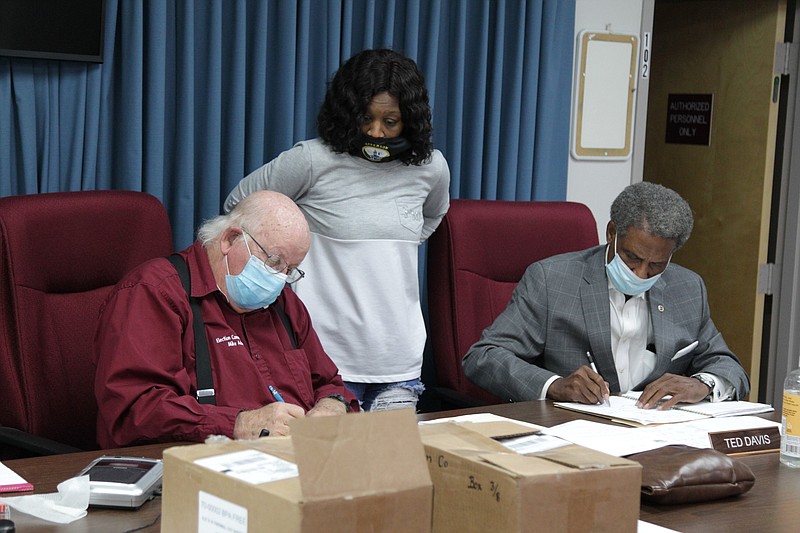The Nov. 3 election results for Jefferson County were certified Friday evening by the county Election Commission after commissioners made final determinations of provisional ballots and entered the vote tabulation of absentee and other ballots that had to be hand-counted because they could not be fed through the tabulation machine.
Three voters appeared for hearings related to their ballots. Two had cast provisional ballots at the polls on Nov. 3, and the third had cast an absentee vote that was rejected because an address was not verified. The two provisional ballots were rejected after it was learned that the voters who cast them had registered on Nov. 3.
Voters must be registered for at least 30 days before the election.
The third voter’s ballot was accepted after she corrected the information on the return envelope and provided verification of her identification.
A fourth voter who arrived late and whose early-vote ballot had been set aside for lack of ID told commissioners he had provided his ID verification earlier.
“He did go to the clerk’s office,” confirmed Tameka Reed, administrative assistant to the commission.
“So why is he here?” asked Mike Adam, election commissioner chairman.
“We called him as well because we were afraid he might not make the deadline,” Reed said. “Because we didn’t have that many letters to send out, we followed up with phone calls to everyone to make sure they knew they had to bring their ID to the clerk by noon today.”
Adam then told the man his ballot had been approved and would be counted.
Three military ballots were received, one of which was rejected because it did not contain necessary paperwork.
“There’s no voter ID and no voter statement attesting to it,” Adam said. “So we’ve got two to count and one not.”
After the hearings, commissioners Adam and Theo-dis “Ted” Davis got down to the laborious task of checking the provisional ballots to ensure they were ready to be counted as Reed sorted the ballots by category and handed them off to election technician Juan Ventress to be counted in the ES&S ExpressVote DS200 vote tabulator.
At 7:17 p.m., about 75 minutes after the meeting began, Adam remarked on the final provisional ballot.
“I believe that is all of them,” he announced.
“Happy days are here again,” Davis remarked.
After that, the commissioners then began hand-counting the ballots that would not go through the tabulator, although Adam urged Ventress to try to run as many through as possible.
“Some of these look like they should go through the counter,” he said. “If we have to count every one of these by hand, it’s going to be a long night.”
Once finished, the commission had approved 34 absentee ballots, two military ballots, six early ballots, and two Election Day ballots that had been cast to be counted. Three ballots, two provisional, were rejected because the voters had not registered in time to vote on Nov. 3, and one military because it lacked a photo identification and a voter statement.
A total of 53 ballots had to be counted by hand because they would not feed through the ballot tabulator. The whole process of hearings, counting cured ballots and hand-counting balky ballots was completed within about 3½ hours.
Adam said next election things should go more smoothly because of what the commission has learned this cycle.
“The ballot envelopes need to be bigger, for one thing,” he said. “Because they are too small, they creased some of the ballots and we we found out, any creases, any marks on the ballots outside of the check boxes, any irregularity can cause them to not go through the ballot tabulator.”
After the proceedings, a few ballots still had to be figured in to the totals manually, but Adam said those ballots would not change any results in any race.
“Nothing we’ve done here tonight would change anything,” Adam said. “All of the results still stand.”
Adam and Davis also approved a revised budget request of $8,200 for the purchase of an additional DS200 tabulator and an EV Marker.
